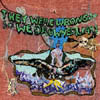 With their first full length release, They Threw us All in a Trench and Stuck a Monument on Top,Liars made their existence known to the world outside Williamsburg asthe most interesting product of that gentrified province, moreintriguing than the achingly deliberate sleaze of the Yeah Yeah Yeahsand decidedly darker than the goofy warble of the Rapture. A few yearsdown the road sees those latter two bands consorting with Carson Dalyand the buzz bin, while the recently shaken Liars lineup (minus theformidable bass and drum duo from the first LP) holed up in a NewJersey basement with their recording equipment and a notebook ofaudience-alienating ideas. The bands' prevailing neuroses have shiftedfrom bombast and bravado to paranoia and claustrophobia, which revealthemselves in oblique chants about witches and magic. "Broken Witch"(perhaps the shortest Liars song title to date) opens the album with adeep electronic pulse that sidles ominously alongside the staggeringdrum kit. Though intentionally hook-less, the song's offbeat, hypnoticfluctuations are as engaging as anything the band has done previously.The track sets the intended mood perfectly, conveying that this albumis not going to be pretty, and that it may not be danceable, but canstill be compelling enough to want to know where the rapidlyaccelerating incantations are leading. "There's Always Room on theBroom" mixes distorted voices and fuzzed out samplers with a creepyfalsetto sing-a-long chorus that eats away at the defenses like amalevolent earworm until the song has completely seized control ofrational judgment and begins to appear on the mind at its own volition.Combined with the hysterical strobe-animation video included with thedisc, the song is a devious and extremely successful attempt atreprogramming listeners and viewers to find the unlistenablelistenable. "They Don't Want Your Corn, They Want Your Kids" is theclosest to the early Liars bass lines and kick beats, a brief reprievefrom the murky fear of tracks like "We Fenced Other Gardens With theBones of Our Own," with its desperate cry of "We're doomed! We'redoomed!" that pierces through the indiscriminate chanting aboutcauldrons and evil spells. These songs capitalize on the darkness andspooky atmosphere that were hinted at in earlier efforts that wereobscured by the snap of a dance-punk bass line, driving the band (andtheir audience) into more and more unfamiliar territory until much oftheir sound and style are unrecognizable. They Were Wrong, So We Drownedis a reactionary record, forged in the glare of the spotlight thrustupon the band in the wake of their catchy debut. Rather than linger inthe comfortable bed they made for themselves, and potentially reap thebenefits of a wider appeal, they chose to start from scratch andchallenge themselves. In the end, the adventurousness of this decisionwill benefit them far more, as Liars have demonstrated that they are acapable, inventive band with more than just one trick up their sleeves.
With their first full length release, They Threw us All in a Trench and Stuck a Monument on Top,Liars made their existence known to the world outside Williamsburg asthe most interesting product of that gentrified province, moreintriguing than the achingly deliberate sleaze of the Yeah Yeah Yeahsand decidedly darker than the goofy warble of the Rapture. A few yearsdown the road sees those latter two bands consorting with Carson Dalyand the buzz bin, while the recently shaken Liars lineup (minus theformidable bass and drum duo from the first LP) holed up in a NewJersey basement with their recording equipment and a notebook ofaudience-alienating ideas. The bands' prevailing neuroses have shiftedfrom bombast and bravado to paranoia and claustrophobia, which revealthemselves in oblique chants about witches and magic. "Broken Witch"(perhaps the shortest Liars song title to date) opens the album with adeep electronic pulse that sidles ominously alongside the staggeringdrum kit. Though intentionally hook-less, the song's offbeat, hypnoticfluctuations are as engaging as anything the band has done previously.The track sets the intended mood perfectly, conveying that this albumis not going to be pretty, and that it may not be danceable, but canstill be compelling enough to want to know where the rapidlyaccelerating incantations are leading. "There's Always Room on theBroom" mixes distorted voices and fuzzed out samplers with a creepyfalsetto sing-a-long chorus that eats away at the defenses like amalevolent earworm until the song has completely seized control ofrational judgment and begins to appear on the mind at its own volition.Combined with the hysterical strobe-animation video included with thedisc, the song is a devious and extremely successful attempt atreprogramming listeners and viewers to find the unlistenablelistenable. "They Don't Want Your Corn, They Want Your Kids" is theclosest to the early Liars bass lines and kick beats, a brief reprievefrom the murky fear of tracks like "We Fenced Other Gardens With theBones of Our Own," with its desperate cry of "We're doomed! We'redoomed!" that pierces through the indiscriminate chanting aboutcauldrons and evil spells. These songs capitalize on the darkness andspooky atmosphere that were hinted at in earlier efforts that wereobscured by the snap of a dance-punk bass line, driving the band (andtheir audience) into more and more unfamiliar territory until much oftheir sound and style are unrecognizable. They Were Wrong, So We Drownedis a reactionary record, forged in the glare of the spotlight thrustupon the band in the wake of their catchy debut. Rather than linger inthe comfortable bed they made for themselves, and potentially reap thebenefits of a wider appeal, they chose to start from scratch andchallenge themselves. In the end, the adventurousness of this decisionwill benefit them far more, as Liars have demonstrated that they are acapable, inventive band with more than just one trick up their sleeves.  With their first full length release, They Threw us All in a Trench and Stuck a Monument on Top,Liars made their existence known to the world outside Williamsburg asthe most interesting product of that gentrified province, moreintriguing than the achingly deliberate sleaze of the Yeah Yeah Yeahsand decidedly darker than the goofy warble of the Rapture. A few yearsdown the road sees those latter two bands consorting with Carson Dalyand the buzz bin, while the recently shaken Liars lineup (minus theformidable bass and drum duo from the first LP) holed up in a NewJersey basement with their recording equipment and a notebook ofaudience-alienating ideas. The bands' prevailing neuroses have shiftedfrom bombast and bravado to paranoia and claustrophobia, which revealthemselves in oblique chants about witches and magic. "Broken Witch"(perhaps the shortest Liars song title to date) opens the album with adeep electronic pulse that sidles ominously alongside the staggeringdrum kit. Though intentionally hook-less, the song's offbeat, hypnoticfluctuations are as engaging as anything the band has done previously.The track sets the intended mood perfectly, conveying that this albumis not going to be pretty, and that it may not be danceable, but canstill be compelling enough to want to know where the rapidlyaccelerating incantations are leading. "There's Always Room on theBroom" mixes distorted voices and fuzzed out samplers with a creepyfalsetto sing-a-long chorus that eats away at the defenses like amalevolent earworm until the song has completely seized control ofrational judgment and begins to appear on the mind at its own volition.Combined with the hysterical strobe-animation video included with thedisc, the song is a devious and extremely successful attempt atreprogramming listeners and viewers to find the unlistenablelistenable. "They Don't Want Your Corn, They Want Your Kids" is theclosest to the early Liars bass lines and kick beats, a brief reprievefrom the murky fear of tracks like "We Fenced Other Gardens With theBones of Our Own," with its desperate cry of "We're doomed! We'redoomed!" that pierces through the indiscriminate chanting aboutcauldrons and evil spells. These songs capitalize on the darkness andspooky atmosphere that were hinted at in earlier efforts that wereobscured by the snap of a dance-punk bass line, driving the band (andtheir audience) into more and more unfamiliar territory until much oftheir sound and style are unrecognizable. They Were Wrong, So We Drownedis a reactionary record, forged in the glare of the spotlight thrustupon the band in the wake of their catchy debut. Rather than linger inthe comfortable bed they made for themselves, and potentially reap thebenefits of a wider appeal, they chose to start from scratch andchallenge themselves. In the end, the adventurousness of this decisionwill benefit them far more, as Liars have demonstrated that they are acapable, inventive band with more than just one trick up their sleeves.
With their first full length release, They Threw us All in a Trench and Stuck a Monument on Top,Liars made their existence known to the world outside Williamsburg asthe most interesting product of that gentrified province, moreintriguing than the achingly deliberate sleaze of the Yeah Yeah Yeahsand decidedly darker than the goofy warble of the Rapture. A few yearsdown the road sees those latter two bands consorting with Carson Dalyand the buzz bin, while the recently shaken Liars lineup (minus theformidable bass and drum duo from the first LP) holed up in a NewJersey basement with their recording equipment and a notebook ofaudience-alienating ideas. The bands' prevailing neuroses have shiftedfrom bombast and bravado to paranoia and claustrophobia, which revealthemselves in oblique chants about witches and magic. "Broken Witch"(perhaps the shortest Liars song title to date) opens the album with adeep electronic pulse that sidles ominously alongside the staggeringdrum kit. Though intentionally hook-less, the song's offbeat, hypnoticfluctuations are as engaging as anything the band has done previously.The track sets the intended mood perfectly, conveying that this albumis not going to be pretty, and that it may not be danceable, but canstill be compelling enough to want to know where the rapidlyaccelerating incantations are leading. "There's Always Room on theBroom" mixes distorted voices and fuzzed out samplers with a creepyfalsetto sing-a-long chorus that eats away at the defenses like amalevolent earworm until the song has completely seized control ofrational judgment and begins to appear on the mind at its own volition.Combined with the hysterical strobe-animation video included with thedisc, the song is a devious and extremely successful attempt atreprogramming listeners and viewers to find the unlistenablelistenable. "They Don't Want Your Corn, They Want Your Kids" is theclosest to the early Liars bass lines and kick beats, a brief reprievefrom the murky fear of tracks like "We Fenced Other Gardens With theBones of Our Own," with its desperate cry of "We're doomed! We'redoomed!" that pierces through the indiscriminate chanting aboutcauldrons and evil spells. These songs capitalize on the darkness andspooky atmosphere that were hinted at in earlier efforts that wereobscured by the snap of a dance-punk bass line, driving the band (andtheir audience) into more and more unfamiliar territory until much oftheir sound and style are unrecognizable. They Were Wrong, So We Drownedis a reactionary record, forged in the glare of the spotlight thrustupon the band in the wake of their catchy debut. Rather than linger inthe comfortable bed they made for themselves, and potentially reap thebenefits of a wider appeal, they chose to start from scratch andchallenge themselves. In the end, the adventurousness of this decisionwill benefit them far more, as Liars have demonstrated that they are acapable, inventive band with more than just one trick up their sleeves.  Meerk is, if the bizarre pseudonym didn't give it away, one of the founders of Providence's Fort Thunder collective as well as a member of the most firmly-entrenched of FT musical incarnations, Forcefield. Those discouraged by the willfully obtuse nature of that group's recorded efforts could do worse than rough up this dirty gem, Puffy's first non-cassette release and one that plays off Forcefield's talents for lo-fi squelch-tronica in welcome fashion. Meerk (aka Matt Brinkman) shoulders the arsenal of bleeps, blats, and digital farts that made Roggaboggas such a throbbing fun time, but he adds a backbone of rhythmic chug and swirling, claustrophobic phase-out, owing as much to the psychedelic skronk aesthetic of early Boredoms as to the cassette noise underground.
Meerk is, if the bizarre pseudonym didn't give it away, one of the founders of Providence's Fort Thunder collective as well as a member of the most firmly-entrenched of FT musical incarnations, Forcefield. Those discouraged by the willfully obtuse nature of that group's recorded efforts could do worse than rough up this dirty gem, Puffy's first non-cassette release and one that plays off Forcefield's talents for lo-fi squelch-tronica in welcome fashion. Meerk (aka Matt Brinkman) shoulders the arsenal of bleeps, blats, and digital farts that made Roggaboggas such a throbbing fun time, but he adds a backbone of rhythmic chug and swirling, claustrophobic phase-out, owing as much to the psychedelic skronk aesthetic of early Boredoms as to the cassette noise underground.
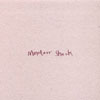 Knowing that this is a collection of music from previous EPs (and then some) makes the joyous and erratic beauty present all that more enjoyable. David Edwards knows what he wants to do with his music: there's not a moment of sound that isn't somehow strangely beautiful, sweetly smooth, or surprisingly fluid. Instruments come together in flirtatious ways and rhythm excuses itself from predictability to usher in the kind of melodic surprises that early electronic bands managed to pull out of their hat through variation in repetition.
Knowing that this is a collection of music from previous EPs (and then some) makes the joyous and erratic beauty present all that more enjoyable. David Edwards knows what he wants to do with his music: there's not a moment of sound that isn't somehow strangely beautiful, sweetly smooth, or surprisingly fluid. Instruments come together in flirtatious ways and rhythm excuses itself from predictability to usher in the kind of melodic surprises that early electronic bands managed to pull out of their hat through variation in repetition.
 That familiar spirit of playful chaos, randomness and intuitive groupimprovisation I've come to expect from Volcano The Bear is in fine formthroughout The Idea Of Wood.Even though VTB have been releasing music since 1996, this LP onTextile Records is only their third full-length studio album. The bulkof their work is scattered across a clutch of live cassettes and CD-Rs,10" vinyl editions, EPs and compilations. The Inhazer Decline and Five Hundred Boy Pianoshowed what the Bear could do when challenged to make a coherent album- tightly produced and concise, yet accurately reproducing the almostaccidental, improvisatory feel of their live shows. This is not an easytask. Consider other free-folk improv ensembles such as Jackie-OMotherfucker, Sunburned Hand of the Man and No Neck Blues Band; theiralbums tend to be hit-or-miss affairs dominated by unfocused meanderingwith occasional eruptions of senseless cacophony. In stark contrast, The Idea of Woodis a study in controlled chaos. VTB's singular grasp of group dynamicslends itself to the album format; their loose, disparate improvisationsare consistently reigned in and alchemized into instant skewed pop.Comparisons to The Residents, Faust and This Heat spring to mind, butthe Bear form their own unique clearing in the woods in which to shit.Itchy, atonal violin scrapes and insect buzzes flit nervously on "SheWhistles, I Cough Like A Tiger," a clattery improv that happens uponsome genuinely riveting moments of pure outsider weirdness. There isclear vibe of woodland ruralism that pervades The Idea Of Wood,as if it were the product of tree-dwelling hermits communicatingthrough a primitive language of acoustical phonetics. Aaron Moore'shushed vocals whispered over the warm buzzes and banjo scales of"Golden Hotbite" sound eerily similar to Robert Wyatt's muttering hobodelivery. "Woman Who Weighs Out The Wood" immerses the listener in anorganic sound environment where a gentle bed of cathedral chanting andmedieval percussion cushions the processed squawking of crows. It'sJohn Renbourn's Sir John A Lot Of as produced by Yamatsuka Eye."Curly Robot" is this album's beating heart, a 10-minute excursion thatbegins with muted jazz but transforms into a simmering invocation ofthe pastoral gods of Frazer's Golden Bough. Miles ahead of theirfree-folk contemporaries, Volcano The Bear's The Idea Of Wood is teeming with life and coursing with sympathetic magic.
That familiar spirit of playful chaos, randomness and intuitive groupimprovisation I've come to expect from Volcano The Bear is in fine formthroughout The Idea Of Wood.Even though VTB have been releasing music since 1996, this LP onTextile Records is only their third full-length studio album. The bulkof their work is scattered across a clutch of live cassettes and CD-Rs,10" vinyl editions, EPs and compilations. The Inhazer Decline and Five Hundred Boy Pianoshowed what the Bear could do when challenged to make a coherent album- tightly produced and concise, yet accurately reproducing the almostaccidental, improvisatory feel of their live shows. This is not an easytask. Consider other free-folk improv ensembles such as Jackie-OMotherfucker, Sunburned Hand of the Man and No Neck Blues Band; theiralbums tend to be hit-or-miss affairs dominated by unfocused meanderingwith occasional eruptions of senseless cacophony. In stark contrast, The Idea of Woodis a study in controlled chaos. VTB's singular grasp of group dynamicslends itself to the album format; their loose, disparate improvisationsare consistently reigned in and alchemized into instant skewed pop.Comparisons to The Residents, Faust and This Heat spring to mind, butthe Bear form their own unique clearing in the woods in which to shit.Itchy, atonal violin scrapes and insect buzzes flit nervously on "SheWhistles, I Cough Like A Tiger," a clattery improv that happens uponsome genuinely riveting moments of pure outsider weirdness. There isclear vibe of woodland ruralism that pervades The Idea Of Wood,as if it were the product of tree-dwelling hermits communicatingthrough a primitive language of acoustical phonetics. Aaron Moore'shushed vocals whispered over the warm buzzes and banjo scales of"Golden Hotbite" sound eerily similar to Robert Wyatt's muttering hobodelivery. "Woman Who Weighs Out The Wood" immerses the listener in anorganic sound environment where a gentle bed of cathedral chanting andmedieval percussion cushions the processed squawking of crows. It'sJohn Renbourn's Sir John A Lot Of as produced by Yamatsuka Eye."Curly Robot" is this album's beating heart, a 10-minute excursion thatbegins with muted jazz but transforms into a simmering invocation ofthe pastoral gods of Frazer's Golden Bough. Miles ahead of theirfree-folk contemporaries, Volcano The Bear's The Idea Of Wood is teeming with life and coursing with sympathetic magic.samples:
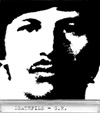 Among those in the know, Deathpile stands out as one of the finestpower electronics acts in the United States today. This incarnation ofthe project, consisting of founder Jonathan Canady and keyboardistDavid E. Williams, is as menacing and unsettling as ever, setting itssights on the true crime story of Gary Leon Ridgeway, ultimately knownas the Green River Killer. From the rumbling tones of the opener"Genesis," it becomes painfully clear that G.R.is a dark and gruesome journey into the sick heart of a serialmurderer. Not suitable for the weak of heart. the subsequent trackscrank up the intensity and the aggression one hundred fold.. Riding thecrushing waves of hot guttural noise on "Addicted" is the inhumanmonologue of Canady's roaring first-person narrative mixed withsnippets from an actual survivor interview. Taking this type of hideousreality-as-entertainment a step further, "Known Victims" painstakinglychronicles Ridgeway's fourty nine known victims over the course oftwelve and a half minutes, with an ironic and ominous female voicemonotonously reciting vital information as if off a checklist. However,the next track "All You'll Ever Get" claims that there may have been asmany as eighty more murdered women, keeping in with the type ofdepraved gloating Canady has already exhibited throughout thispersonification. Refusing to let up even after capture and arrest,"Kenworth" displays the murderer's defiance and sense ofaccomplishment, augmented by the track's nauseating mantra of "Who'slaughing now?" By the time the curious and vulgar unanswered questionsof "You Will Never Know"arrive, Deathpile's aural and psychologicalassault has left its mark, and the uncertainties reverberate endlesslyin the murky pool of phasing electronics. While the inclusion of alyric booklet may result in some snickering among the jaded types, theoverall quality of these tracks cannot be overlooked. Concise andto-the-point like all power electronics albums should be, G.R.represents a powerful and memorable moment in not only Deathpile'smusical career but also in record labels Force of Nature and Hospital.As the possibility of a final Deathpile performance looms (tentativelyscheduled to take place in March in New York City), this album may verywell be one of the final chapters in the history of this project, anending that is as uneasy to swallow as that of Gary Ridgeway.
Among those in the know, Deathpile stands out as one of the finestpower electronics acts in the United States today. This incarnation ofthe project, consisting of founder Jonathan Canady and keyboardistDavid E. Williams, is as menacing and unsettling as ever, setting itssights on the true crime story of Gary Leon Ridgeway, ultimately knownas the Green River Killer. From the rumbling tones of the opener"Genesis," it becomes painfully clear that G.R.is a dark and gruesome journey into the sick heart of a serialmurderer. Not suitable for the weak of heart. the subsequent trackscrank up the intensity and the aggression one hundred fold.. Riding thecrushing waves of hot guttural noise on "Addicted" is the inhumanmonologue of Canady's roaring first-person narrative mixed withsnippets from an actual survivor interview. Taking this type of hideousreality-as-entertainment a step further, "Known Victims" painstakinglychronicles Ridgeway's fourty nine known victims over the course oftwelve and a half minutes, with an ironic and ominous female voicemonotonously reciting vital information as if off a checklist. However,the next track "All You'll Ever Get" claims that there may have been asmany as eighty more murdered women, keeping in with the type ofdepraved gloating Canady has already exhibited throughout thispersonification. Refusing to let up even after capture and arrest,"Kenworth" displays the murderer's defiance and sense ofaccomplishment, augmented by the track's nauseating mantra of "Who'slaughing now?" By the time the curious and vulgar unanswered questionsof "You Will Never Know"arrive, Deathpile's aural and psychologicalassault has left its mark, and the uncertainties reverberate endlesslyin the murky pool of phasing electronics. While the inclusion of alyric booklet may result in some snickering among the jaded types, theoverall quality of these tracks cannot be overlooked. Concise andto-the-point like all power electronics albums should be, G.R.represents a powerful and memorable moment in not only Deathpile'smusical career but also in record labels Force of Nature and Hospital.As the possibility of a final Deathpile performance looms (tentativelyscheduled to take place in March in New York City), this album may verywell be one of the final chapters in the history of this project, anending that is as uneasy to swallow as that of Gary Ridgeway.samples:
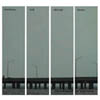 The next addition to in increasing collection of music by thesefantastically driven sonic players (see: Trapist, Radian, Dean Roberts)marries some of the free jazz tendencies with an affinity for retronoisemaking devices. Whereas the Trapist album reviewed last week wouldappeal to a number of Talk Talk fans, this album will probably find awarm place in the heart of many Wolf Eyes fans. While the liner notesdescribe the process of recording with respect to a room's atmosphereand space, my own mental image of the record is quite different. I seea very alien world. A world where the physical laws of nature that wehave grown accustomed to on this planet do not necessarily apply. Newcolors, new landscapes, and a new language, all of which are neitherdescribable nor translatable, but something which has to be experiencedfirst hand to truly appreciated. Recorded in 2001 and 2002, faintlytapped drum kits and timid guitars provide stability and recognitionwhile outbursts of analogue static and high frequency communicationlines blur the electromagnetism in the atmosphere. The planet and itscharacteristics are brilliantly established through "Part 1" and "Part2," while by "Part 3," actual beings are seemingly introduced. Like theutter bizzareness of the film Fantastic Planet,these foreign beings do not take recongnizable forms nor communicate inthe same way humans understand. It's on this track, "Part 3," whereit's almost as if a conversation is taking place between the aliens.Whether or not the quartet is imagining such a world during theirrecording is a different story, but the music created between themembers is very conversational, simply without words as we know them."Part 4" is much like a human contact would be to this new world. Thealien landscapes have been established but the guitar introducesitself, and at first, tries to mimic the electronic hums, drones andsqueals. As the contact between explorers and natives develops, eachtake turns in demonstrating what each species can do: the guitar andbass begin to play more familiar lines and between riffs, seems toalternate with the electronics for attention focus. This continues andescalates to the point of everybody playing together in a audio soup ofsorts, where everybody has let down their guard and has grown afondness for sharing themselves with new found friends. If Die InstabilitŠt der Symmetrieis like a visit to an alien world, the final track, "Part 5" is muchlike the sorrowful departure, as the melodies and tunes form in a veryconcluding manner, with low bass notes in a melancholy motion as thenew found friends must say goodbye, perhaps forever. The ship driftsoff into space as the whirry hums quell in the end. Fade to black. As aviewer to my own interpretation of the album as a fictitiousdocumentary, I hope the explorers and natives will meet up again someother day for another rewarding adventure.
The next addition to in increasing collection of music by thesefantastically driven sonic players (see: Trapist, Radian, Dean Roberts)marries some of the free jazz tendencies with an affinity for retronoisemaking devices. Whereas the Trapist album reviewed last week wouldappeal to a number of Talk Talk fans, this album will probably find awarm place in the heart of many Wolf Eyes fans. While the liner notesdescribe the process of recording with respect to a room's atmosphereand space, my own mental image of the record is quite different. I seea very alien world. A world where the physical laws of nature that wehave grown accustomed to on this planet do not necessarily apply. Newcolors, new landscapes, and a new language, all of which are neitherdescribable nor translatable, but something which has to be experiencedfirst hand to truly appreciated. Recorded in 2001 and 2002, faintlytapped drum kits and timid guitars provide stability and recognitionwhile outbursts of analogue static and high frequency communicationlines blur the electromagnetism in the atmosphere. The planet and itscharacteristics are brilliantly established through "Part 1" and "Part2," while by "Part 3," actual beings are seemingly introduced. Like theutter bizzareness of the film Fantastic Planet,these foreign beings do not take recongnizable forms nor communicate inthe same way humans understand. It's on this track, "Part 3," whereit's almost as if a conversation is taking place between the aliens.Whether or not the quartet is imagining such a world during theirrecording is a different story, but the music created between themembers is very conversational, simply without words as we know them."Part 4" is much like a human contact would be to this new world. Thealien landscapes have been established but the guitar introducesitself, and at first, tries to mimic the electronic hums, drones andsqueals. As the contact between explorers and natives develops, eachtake turns in demonstrating what each species can do: the guitar andbass begin to play more familiar lines and between riffs, seems toalternate with the electronics for attention focus. This continues andescalates to the point of everybody playing together in a audio soup ofsorts, where everybody has let down their guard and has grown afondness for sharing themselves with new found friends. If Die InstabilitŠt der Symmetrieis like a visit to an alien world, the final track, "Part 5" is muchlike the sorrowful departure, as the melodies and tunes form in a veryconcluding manner, with low bass notes in a melancholy motion as thenew found friends must say goodbye, perhaps forever. The ship driftsoff into space as the whirry hums quell in the end. Fade to black. As aviewer to my own interpretation of the album as a fictitiousdocumentary, I hope the explorers and natives will meet up again someother day for another rewarding adventure.samples:
 Okay, already, I take it all back. The EP from this Brighton foursome released late last year didn't light me up, but this record is a delight from first track to last, and in between it has just enough touches of brilliance to guarantee a place in my CD player for weeks or months to come.
Okay, already, I take it all back. The EP from this Brighton foursome released late last year didn't light me up, but this record is a delight from first track to last, and in between it has just enough touches of brilliance to guarantee a place in my CD player for weeks or months to come.
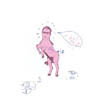 Andrew W.K. and Pink have never sounded better. Britney Spears andJustin Timberlake can be enjoyable! So long as the combination ofapples being gnawed up, pigs snorting, children laughing, andelephant-speak is processed, destroyed, and turned into a headfuck ofan album; then bad music can be made beautiful. Secret Mommy specializein the annihilation of all that sucks (including French educationalrecords) and all that can be used to make the pain of bad music lessexcruciating. The thirteen tracks on Mammal Classare composed of the dead bodies of pop stars, the flucuating anddecaying breath of large mammals, and various instruments that may ormay not be readily indentifiable; but who cares? This sort of thing hasbeen done for a while, now! What could possibly make me want to spendmoney on this record? First of all, "Bottom 40" features aspeak n' spell alongside Britney Spears and the mating calls of catsand turns out to be one hilarious and nerdy ride through funkdom.Second of all, the whole of this record is hilarious! "Shania Twang" isthe best combination possible of cowboy screams, mouth harp, ShaniaTwain samples, pigs, chickens, and off key banjo. "Andrew W. Cake" iscatchy, spontaneous, and makes the best use of Andrew W.K.'s outrageousmusic all while serving as a therapeutic means of getting back at allthose celebrities I've come to hate by using them in ways that wouldmake certain record companies jealous. Besides the funny aspect, a lotof the music here is just plain fun to listen to; it's the bestsynthesis of creativity and accessibility that I've found in a longwhile. What isn't cool about frogs, guitars, and girls being used tocreate rhythms that would send any dancing feet into the stratosphereand would also happen make certain "IDM" provocateurs red in the facefor their academic journey into blandness? Incessant giggling, goodtunes, and a real live imagination is the name of the game; this is themost entertaining time I've had listening to a record in forever. It'sextravagant, lushly melodic, and a real benchmark for other purveyorsof the strange and wonderous to test themselves by.
Andrew W.K. and Pink have never sounded better. Britney Spears andJustin Timberlake can be enjoyable! So long as the combination ofapples being gnawed up, pigs snorting, children laughing, andelephant-speak is processed, destroyed, and turned into a headfuck ofan album; then bad music can be made beautiful. Secret Mommy specializein the annihilation of all that sucks (including French educationalrecords) and all that can be used to make the pain of bad music lessexcruciating. The thirteen tracks on Mammal Classare composed of the dead bodies of pop stars, the flucuating anddecaying breath of large mammals, and various instruments that may ormay not be readily indentifiable; but who cares? This sort of thing hasbeen done for a while, now! What could possibly make me want to spendmoney on this record? First of all, "Bottom 40" features aspeak n' spell alongside Britney Spears and the mating calls of catsand turns out to be one hilarious and nerdy ride through funkdom.Second of all, the whole of this record is hilarious! "Shania Twang" isthe best combination possible of cowboy screams, mouth harp, ShaniaTwain samples, pigs, chickens, and off key banjo. "Andrew W. Cake" iscatchy, spontaneous, and makes the best use of Andrew W.K.'s outrageousmusic all while serving as a therapeutic means of getting back at allthose celebrities I've come to hate by using them in ways that wouldmake certain record companies jealous. Besides the funny aspect, a lotof the music here is just plain fun to listen to; it's the bestsynthesis of creativity and accessibility that I've found in a longwhile. What isn't cool about frogs, guitars, and girls being used tocreate rhythms that would send any dancing feet into the stratosphereand would also happen make certain "IDM" provocateurs red in the facefor their academic journey into blandness? Incessant giggling, goodtunes, and a real live imagination is the name of the game; this is themost entertaining time I've had listening to a record in forever. It'sextravagant, lushly melodic, and a real benchmark for other purveyorsof the strange and wonderous to test themselves by. samples:
 It is nearly impossible to discuss Camera Obscura without mentioningtheir fellow countrymen and kindred spirits Belle & Sebastian. Thecover photograph of the former's second album was taken by B&Sfrontman Stuart Murdoch (which alone screams of his own band's retro /twee stylings), in addition, he has produced one of Camera Obscura'searlier tracks. While CO might seem to owe a heavy debt to them, it isinteresting to note that both bands formed in 1996, and although theiroverall aesthetic is similar, the two clearly spring from differentminds. Underachievers Please Try Harderputs the band squarely in the realm of jangle-pop, and primary vocalistTraceyanne Campbell's gentle, breezy, inobtrusive vocals are perfectlycomplimentary. "Suspended from Class," "Teenager," and "Keep it Clean"are all classic examples of the genre with their sunny, simpleconstruction and topped off with twee lyrics. There are, however, a fewunexpected twists in this overall sound. "A Sister's Social Agony" hasechoes of the angelic, dreamy pop your parents might have danced to attheir prom, while "Your Picture" has a suprisingly melancholic tone.The latter may be the result of the Morrissey-esque male vocalist whotakes over for a few of the tracks. It is ultimately Camera Obscura'slyrics which seem to save them from lapsing into a saccharine overload.They are marked more by a pensive reflection on adolescence than bymere nostalgia. And although they aren't breaking any new ground withtheir music, they good a fine job of carrying the torch passed down tothem by their C86 forefathers.
It is nearly impossible to discuss Camera Obscura without mentioningtheir fellow countrymen and kindred spirits Belle & Sebastian. Thecover photograph of the former's second album was taken by B&Sfrontman Stuart Murdoch (which alone screams of his own band's retro /twee stylings), in addition, he has produced one of Camera Obscura'searlier tracks. While CO might seem to owe a heavy debt to them, it isinteresting to note that both bands formed in 1996, and although theiroverall aesthetic is similar, the two clearly spring from differentminds. Underachievers Please Try Harderputs the band squarely in the realm of jangle-pop, and primary vocalistTraceyanne Campbell's gentle, breezy, inobtrusive vocals are perfectlycomplimentary. "Suspended from Class," "Teenager," and "Keep it Clean"are all classic examples of the genre with their sunny, simpleconstruction and topped off with twee lyrics. There are, however, a fewunexpected twists in this overall sound. "A Sister's Social Agony" hasechoes of the angelic, dreamy pop your parents might have danced to attheir prom, while "Your Picture" has a suprisingly melancholic tone.The latter may be the result of the Morrissey-esque male vocalist whotakes over for a few of the tracks. It is ultimately Camera Obscura'slyrics which seem to save them from lapsing into a saccharine overload.They are marked more by a pensive reflection on adolescence than bymere nostalgia. And although they aren't breaking any new ground withtheir music, they good a fine job of carrying the torch passed down tothem by their C86 forefathers. samples:
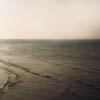 Ielasi will be best known for his label, Fringes, which has beenbrightening the Italian improv community for the past six years with aslew of successful releases. Starting out as a guitarist, he performedin several bristly, tense ensembles (even playing acoustic at times)before easing into electronic improvisation, a transition thatintroduced a more understated method of expression and produced worksthat, while full of the scrape and bounce that characterize Ielasi'sguitar-playing, contain new attention towards careful sculpting of thesmooth approach and weightless hover of each piece. Such concerns haveexploded with Plans;at only thirty minutes, the piece is a major addition to Ielasi'salready-intimidating catalog and marks a considerable stylistic shiftfor the artist. Not a work of pure improvisation, Plans wasactually created over a sixteen-month interval and is of remarkablydense construction, including everything from layered field recordings,thick accumulations of vinyl surface noise, and a toy museum's worth ofclatter and acoustic tinker, to the surprisingly "present"accompaniment of live drums and Ielasi's narcotic strumming. Not onlydoes Plans travel through a succession of movements, but themusic transitions with rare, effortless stride, captivating in itsjoining of contrastive sounds and playing styles, over passages thatnot only sound perfectly-aligned but maintain an emotional current thatremains close to the surface. This is the power of Plans; itsimmediately palpable, almost nostalgic beauty becomes a catalyst forforgetting just how intact Ielasi leaves his sound sources. Plaintivechordal phrasing lines up neatly next to the most atonal, asymmetricalbits of sturm und drang, all sounds recognizably different, even (itwould seem) in direction, but down to the slightest of details each onefits and seems created with full knowledge of every foreign item thatwill graze its path. Like the artist's recent improvisations, Planslifts dense assemblage to airy heights without the sacrifice of thesounds' material qualities. One particularly illuminating moment comesin the third or fourth "movement" when out of breezy, layered surfacenoise Ielasi introduces a pristine recording of keys fumbling and heavymetal doors being swung open and shut. These harsh, solid soundsimmediately take their place within the airborne whisper of the whole,an explicit representation of Plans' achievement, iron doorsswinging between the clouds. It is not hard to believe that thisrelatively short piece took so long to create. Even the improvisedelements appear intricately placed, often spliced via electronics tofit the multiplicity of layers and the "larger," more demandingcompositional structure. This music demands repeated listening, and itsrewards, I've found, are almost limitless, such that I cannot evenmuster predictable criticism of the disc's short length. Plansis an easy favorite from the new crop of Sedimental releases and leavesme hoping Ielasi's next work will continue in similar stride.
Ielasi will be best known for his label, Fringes, which has beenbrightening the Italian improv community for the past six years with aslew of successful releases. Starting out as a guitarist, he performedin several bristly, tense ensembles (even playing acoustic at times)before easing into electronic improvisation, a transition thatintroduced a more understated method of expression and produced worksthat, while full of the scrape and bounce that characterize Ielasi'sguitar-playing, contain new attention towards careful sculpting of thesmooth approach and weightless hover of each piece. Such concerns haveexploded with Plans;at only thirty minutes, the piece is a major addition to Ielasi'salready-intimidating catalog and marks a considerable stylistic shiftfor the artist. Not a work of pure improvisation, Plans wasactually created over a sixteen-month interval and is of remarkablydense construction, including everything from layered field recordings,thick accumulations of vinyl surface noise, and a toy museum's worth ofclatter and acoustic tinker, to the surprisingly "present"accompaniment of live drums and Ielasi's narcotic strumming. Not onlydoes Plans travel through a succession of movements, but themusic transitions with rare, effortless stride, captivating in itsjoining of contrastive sounds and playing styles, over passages thatnot only sound perfectly-aligned but maintain an emotional current thatremains close to the surface. This is the power of Plans; itsimmediately palpable, almost nostalgic beauty becomes a catalyst forforgetting just how intact Ielasi leaves his sound sources. Plaintivechordal phrasing lines up neatly next to the most atonal, asymmetricalbits of sturm und drang, all sounds recognizably different, even (itwould seem) in direction, but down to the slightest of details each onefits and seems created with full knowledge of every foreign item thatwill graze its path. Like the artist's recent improvisations, Planslifts dense assemblage to airy heights without the sacrifice of thesounds' material qualities. One particularly illuminating moment comesin the third or fourth "movement" when out of breezy, layered surfacenoise Ielasi introduces a pristine recording of keys fumbling and heavymetal doors being swung open and shut. These harsh, solid soundsimmediately take their place within the airborne whisper of the whole,an explicit representation of Plans' achievement, iron doorsswinging between the clouds. It is not hard to believe that thisrelatively short piece took so long to create. Even the improvisedelements appear intricately placed, often spliced via electronics tofit the multiplicity of layers and the "larger," more demandingcompositional structure. This music demands repeated listening, and itsrewards, I've found, are almost limitless, such that I cannot evenmuster predictable criticism of the disc's short length. Plansis an easy favorite from the new crop of Sedimental releases and leavesme hoping Ielasi's next work will continue in similar stride. samples:
 Though odder and odder this one becomes with each listen, I think I'vefinally found the piece of my heart that loves The Elected. With onefoot planted firmly in the indie psyche-rock weeds and the other in themore low-down country aspects of life, this Los Angeles ensemble playswith genres and styles in an effort to find their niche, but the truthis they needn't try so hard sometimes. Me Firstis a well-paced and structured debut with funny, intelligent lyricsabout classic themes but with clever twists. All the while, there'splenty to swallow whole, as savoring it instead of devouring it won'tmake it any more logical or understood, like the finer moments of theFlaming Lips or the Shins. This is the road trip record for drivingthrough the dusty south and southwest, with pure Americana and shortstories to keep the feet firmly on the ground, though the mind is freeto roam. Blake Sennett, principal songwriter and guitarist in RiloKiley, is also the mastermind behind The Elected, and certainsimilarities can be found in the two bands. Sennett seems to have someya-yas to get out about relationships, though, and that's where thesesongs have their strengths. Whether it's failed romantic relationshipsor hiding the secrets from family and friends, the subjects of thesongs are lived-in, and that's the the real appeal of The Elected'sdebut. In the age of vapid and vacant pop stars who steal the beats andbasslines of classic songs to try and duplicate the stardom or revive agenre bigger than them, it's nice to hear a band that can just do theirthing and sound like they've been around forever making music with thebands of the age. This is record I will be listening to all year, I canjust feel it.
Though odder and odder this one becomes with each listen, I think I'vefinally found the piece of my heart that loves The Elected. With onefoot planted firmly in the indie psyche-rock weeds and the other in themore low-down country aspects of life, this Los Angeles ensemble playswith genres and styles in an effort to find their niche, but the truthis they needn't try so hard sometimes. Me Firstis a well-paced and structured debut with funny, intelligent lyricsabout classic themes but with clever twists. All the while, there'splenty to swallow whole, as savoring it instead of devouring it won'tmake it any more logical or understood, like the finer moments of theFlaming Lips or the Shins. This is the road trip record for drivingthrough the dusty south and southwest, with pure Americana and shortstories to keep the feet firmly on the ground, though the mind is freeto roam. Blake Sennett, principal songwriter and guitarist in RiloKiley, is also the mastermind behind The Elected, and certainsimilarities can be found in the two bands. Sennett seems to have someya-yas to get out about relationships, though, and that's where thesesongs have their strengths. Whether it's failed romantic relationshipsor hiding the secrets from family and friends, the subjects of thesongs are lived-in, and that's the the real appeal of The Elected'sdebut. In the age of vapid and vacant pop stars who steal the beats andbasslines of classic songs to try and duplicate the stardom or revive agenre bigger than them, it's nice to hear a band that can just do theirthing and sound like they've been around forever making music with thebands of the age. This is record I will be listening to all year, I canjust feel it.samples:
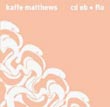 CD Eb + Flo marks a number of departures in the work of one of today's most interesting sound artists. The double-disc is Matthews' first solo release using theremin as primary sound source, following her retiring of the violin which had formed the core of her excellent first three discs (recently reissued as a trio). The artist's method remains somewhat constant on Eb + Flo, involving the live sampling and laptop manipulation of sounds created with the theremin and projected via quadraphonic soundsystem throughout a particular room.
CD Eb + Flo marks a number of departures in the work of one of today's most interesting sound artists. The double-disc is Matthews' first solo release using theremin as primary sound source, following her retiring of the violin which had formed the core of her excellent first three discs (recently reissued as a trio). The artist's method remains somewhat constant on Eb + Flo, involving the live sampling and laptop manipulation of sounds created with the theremin and projected via quadraphonic soundsystem throughout a particular room.
 Aranos is a unique musician, a classically-trained cellist andmulti-instrumentalist whose resume is not filled with the usual chambermusic ensembles, modern composition or minimalist drone work that onemight expect. Instead, he has become noteworthy based on a series ofuncategorizable collaborations with Nurse With Wound that sidestep allof the usual implications of avant-classical composition. Aranos'peculiar style is based in the Eastern European gypsy songs, trad-folkand rock music of his childhood in Czechoslovakia. From hiscollaborations with Steven Stapleton, he absorbed the techniques ofdislocated psychedelia and surrealistic composition. Those techniqueswere in full display with the Irish jigs, skewed gypsy fiddles andcracked experimentation of his first two albums for his own Pieroslabel. For this album, Aranos collaborates with El Monte, the nom deguerre of Nick Mott of Volcano The Bear. Allied Cooking But Not As You Know It!is a collection of eleven improvised tracks, utilizing an array ofinstruments including the usual strings, shakahuchi, trumpet,saxophone, gongs and an array of homemade instruments. In a techniqueworthy of Eno's Oblique Strategies, each improvisation is based uponmeditation on a nonsensical imperative — "Think Like Warm IntestinalBeing!" or "Think Like Madly Projected Fleshcups!" Their collaborationresults in a series of low key tracks, meandering around a series ofsubtle conversations that scrupulously avoid musicality entirely.Several tracks create the abstract mental imagery of dark jungles anddamp marshes, with the slowly rubbed cello strings creating an creepingatmosphere of dread. At other times, the music is decidedly morehyperactive, Aranos jumping over his strings like a frog in a fryingpan. On "Think Like Veering Toads and Rude Proons!" an odd speakerglitch creates a brief piece of minimalist electronica worthy of theRaster-Noton label. Apparently, this was all recorded and mixed in thespan of a week that El Monte spent in Ireland with Aranos.Unfortunately, this really shows, as the whole affair seems to sufferfrom a severe dearth of well-executed musical ideas, attempting tocompensate for this lack with an overdose of creepy atmospherics,exclamation points and surreal gobbledygook.
Aranos is a unique musician, a classically-trained cellist andmulti-instrumentalist whose resume is not filled with the usual chambermusic ensembles, modern composition or minimalist drone work that onemight expect. Instead, he has become noteworthy based on a series ofuncategorizable collaborations with Nurse With Wound that sidestep allof the usual implications of avant-classical composition. Aranos'peculiar style is based in the Eastern European gypsy songs, trad-folkand rock music of his childhood in Czechoslovakia. From hiscollaborations with Steven Stapleton, he absorbed the techniques ofdislocated psychedelia and surrealistic composition. Those techniqueswere in full display with the Irish jigs, skewed gypsy fiddles andcracked experimentation of his first two albums for his own Pieroslabel. For this album, Aranos collaborates with El Monte, the nom deguerre of Nick Mott of Volcano The Bear. Allied Cooking But Not As You Know It!is a collection of eleven improvised tracks, utilizing an array ofinstruments including the usual strings, shakahuchi, trumpet,saxophone, gongs and an array of homemade instruments. In a techniqueworthy of Eno's Oblique Strategies, each improvisation is based uponmeditation on a nonsensical imperative — "Think Like Warm IntestinalBeing!" or "Think Like Madly Projected Fleshcups!" Their collaborationresults in a series of low key tracks, meandering around a series ofsubtle conversations that scrupulously avoid musicality entirely.Several tracks create the abstract mental imagery of dark jungles anddamp marshes, with the slowly rubbed cello strings creating an creepingatmosphere of dread. At other times, the music is decidedly morehyperactive, Aranos jumping over his strings like a frog in a fryingpan. On "Think Like Veering Toads and Rude Proons!" an odd speakerglitch creates a brief piece of minimalist electronica worthy of theRaster-Noton label. Apparently, this was all recorded and mixed in thespan of a week that El Monte spent in Ireland with Aranos.Unfortunately, this really shows, as the whole affair seems to sufferfrom a severe dearth of well-executed musical ideas, attempting tocompensate for this lack with an overdose of creepy atmospherics,exclamation points and surreal gobbledygook. samples:
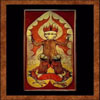 Dave Wright's approach to music serves as his greatest strength and thehinge upon which his weakness rests. Near every song on his newestrelease has a soundtrack quality to it, coming across as if it belongedto any number of gritty sci-fi movies from the past twenty years. Thereare layers upon layers of jumbled drum tracks, erratic signal chaos,computer malfunctions, and muscular bass melodies. I can see the floorsof abandoned houses soaked and creaking from numerous leaks, the lightof candles flickering across the walls, and the awkward crawl ofshadows jumping across the room with the sudden gusts of air billowingthrough the rooms; but what's missing is some element that keeps mewanting to come back. Carrion Soundsfeels so thematic that I find that I have difficulty maintaininginterest throughout the album. By the time "Worlock Radar" drops itsblack breath over my head, I'm feeling rather removed from the musicand there's little making me want to get back into it. Some of thesongs just over-extend their welcome: seven minutes of insane drumprogramming and strobe-light special effects is difficult to sitthrough unless it's done to perfection. With that in mind, "BebeBarron's Panties" (featuring Mr. Meat Beat Manifesto) is a realstandout: it isn't one of the longest tracks on the disc, but the spacethat Jack Dangers provides in between the sounds improves the formulathat Not Breathing works with throughout the duration of the album. Carrion Soundsis unique, however, many of the sounds have a life all their own anddon't feel overused or familiar. David Wright certainly providesinteresting rhythmic and melodic combinations, but overall fails tokeep my attention for a long stretch of time. I find the record pullingat me every now then for a quick and heavy dose, but the record is besttaken in steps: Wright certainly has a lot of talent, just a littlerefinement and this record would be excellent.
Dave Wright's approach to music serves as his greatest strength and thehinge upon which his weakness rests. Near every song on his newestrelease has a soundtrack quality to it, coming across as if it belongedto any number of gritty sci-fi movies from the past twenty years. Thereare layers upon layers of jumbled drum tracks, erratic signal chaos,computer malfunctions, and muscular bass melodies. I can see the floorsof abandoned houses soaked and creaking from numerous leaks, the lightof candles flickering across the walls, and the awkward crawl ofshadows jumping across the room with the sudden gusts of air billowingthrough the rooms; but what's missing is some element that keeps mewanting to come back. Carrion Soundsfeels so thematic that I find that I have difficulty maintaininginterest throughout the album. By the time "Worlock Radar" drops itsblack breath over my head, I'm feeling rather removed from the musicand there's little making me want to get back into it. Some of thesongs just over-extend their welcome: seven minutes of insane drumprogramming and strobe-light special effects is difficult to sitthrough unless it's done to perfection. With that in mind, "BebeBarron's Panties" (featuring Mr. Meat Beat Manifesto) is a realstandout: it isn't one of the longest tracks on the disc, but the spacethat Jack Dangers provides in between the sounds improves the formulathat Not Breathing works with throughout the duration of the album. Carrion Soundsis unique, however, many of the sounds have a life all their own anddon't feel overused or familiar. David Wright certainly providesinteresting rhythmic and melodic combinations, but overall fails tokeep my attention for a long stretch of time. I find the record pullingat me every now then for a quick and heavy dose, but the record is besttaken in steps: Wright certainly has a lot of talent, just a littlerefinement and this record would be excellent. samples:
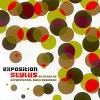 The meeting-of-the-minds approach is extremely popular in the remix realm, bringing a new edge and almost rebirth to the music. It's almost designed to backfire on occasion, where the new work is different enough from the original works of the two main ingredients that fans of either are not impressed. It can also be magical, where the new work transcends the original. Unfortunately, this "remix" of Stylus tracks by EAR lies in a third area, where the new work becomes so convoluted and strange that it's almost better used as a cure for insomnia.
The meeting-of-the-minds approach is extremely popular in the remix realm, bringing a new edge and almost rebirth to the music. It's almost designed to backfire on occasion, where the new work is different enough from the original works of the two main ingredients that fans of either are not impressed. It can also be magical, where the new work transcends the original. Unfortunately, this "remix" of Stylus tracks by EAR lies in a third area, where the new work becomes so convoluted and strange that it's almost better used as a cure for insomnia.
 Whoever considers Einstürzende Neubauten's musical output from the 1990s to be lackluster has got to be tone deaf. The group opened the decade with a forceful sound that began to integrate their noise tendencies with clever musical arrangement and song craftsmanship. Haus der Lüge—although released in 1989—started the phase off, paving the way for 1993's Tabula Rasa, which was a complete breakthrough marrying elegance, sound exploration, composition, and noise.
Whoever considers Einstürzende Neubauten's musical output from the 1990s to be lackluster has got to be tone deaf. The group opened the decade with a forceful sound that began to integrate their noise tendencies with clever musical arrangement and song craftsmanship. Haus der Lüge—although released in 1989—started the phase off, paving the way for 1993's Tabula Rasa, which was a complete breakthrough marrying elegance, sound exploration, composition, and noise. John Darnielle has the reputation of being a consummate storyteller.His prolific output contains a variety of song cycles and storylinesthat unfold in chapters throughout his catalog, as well as individualvignettes that rise and fall in the space of a scant few minutes. Whatmakes his stories viable is the deep sense of urgency and passion thathe imbues them with. On early records like Zopilote Machineit seemed as if these tales were so heavy, so grand, that he couldn'tpossibly wait to confess them to his recording boom box, to give themlife with a reedy voice that made it clear to the listener that thesewords were important, and these stories were important. His firstrecord on 4AD, the immensely wonderful Tallahassee, proved thatthe cassette medium was not the magic that gave his songs life. Thefirst all-studio Mountain Goats album, it sounded every bit asimmediate, sometimes warm and sometimes caustic, but alwayscaptivating. We Shall All Be Healed claims to document acollection of characters that Darnielle knows (or knew) in real life, aslice of time where these characters moved about each other and playedan important role in a larger story. While it seems as if that shouldbe no trouble for the Mountain Goats, the storyline presents itself ina far more patient, meditative manner than the last effort. Perhaps itis the proximity of the subjects to the author, but the incisiveobservations and illuminating metaphors that traditionally overpopulatehis songs are strangely absent. Darnielle's voice dwells in a moderate,plaintive register for much of the album. Many of the songs seem likethey are indistinct messages to a single individual. Ideas appear asreferences without context, or nostalgic wisps that never really takeform, and leave a craving for some kind of impact that must lurksomewhere in the formlessness. "Home Again Garden Grove" peeks its headout with a glimpse of what we're used to. The vocals are crisp, directand pointed, and with lines like, "I can remember when we were in highschool / our dreams were like fugitive warlords / plotting triumphantreturns to the city / with tec-9's tucked under the floorboards /ah-ah-ha," it's a pleasing respite from the lack of concentration thatdominates the other songs. Perhaps more disappointing than thedisconnection of the lyrics is the simply flat sound of the music, likea soda left in the open air for too long. "Mole," which features anunfortunately under-observed scene in an intensive care unit features athreadbare guitar that absently plucks away at what sounds like a roughapproximation of the theme song to Hill Street Blues. There is verylittle energy in what is heard, and it is not a question of raucousspeed or volume, but of thoughtful investments in crafting a song thatdoes not merely plod along a stale strum or hackneyed change. We Shall All Be Healedsounds an arm's length away, a record that wishes to keep its distanceand wrap its secrets in a collection of comfortable tones thatcamouflage whatever kind of power they truly have in reality.
John Darnielle has the reputation of being a consummate storyteller.His prolific output contains a variety of song cycles and storylinesthat unfold in chapters throughout his catalog, as well as individualvignettes that rise and fall in the space of a scant few minutes. Whatmakes his stories viable is the deep sense of urgency and passion thathe imbues them with. On early records like Zopilote Machineit seemed as if these tales were so heavy, so grand, that he couldn'tpossibly wait to confess them to his recording boom box, to give themlife with a reedy voice that made it clear to the listener that thesewords were important, and these stories were important. His firstrecord on 4AD, the immensely wonderful Tallahassee, proved thatthe cassette medium was not the magic that gave his songs life. Thefirst all-studio Mountain Goats album, it sounded every bit asimmediate, sometimes warm and sometimes caustic, but alwayscaptivating. We Shall All Be Healed claims to document acollection of characters that Darnielle knows (or knew) in real life, aslice of time where these characters moved about each other and playedan important role in a larger story. While it seems as if that shouldbe no trouble for the Mountain Goats, the storyline presents itself ina far more patient, meditative manner than the last effort. Perhaps itis the proximity of the subjects to the author, but the incisiveobservations and illuminating metaphors that traditionally overpopulatehis songs are strangely absent. Darnielle's voice dwells in a moderate,plaintive register for much of the album. Many of the songs seem likethey are indistinct messages to a single individual. Ideas appear asreferences without context, or nostalgic wisps that never really takeform, and leave a craving for some kind of impact that must lurksomewhere in the formlessness. "Home Again Garden Grove" peeks its headout with a glimpse of what we're used to. The vocals are crisp, directand pointed, and with lines like, "I can remember when we were in highschool / our dreams were like fugitive warlords / plotting triumphantreturns to the city / with tec-9's tucked under the floorboards /ah-ah-ha," it's a pleasing respite from the lack of concentration thatdominates the other songs. Perhaps more disappointing than thedisconnection of the lyrics is the simply flat sound of the music, likea soda left in the open air for too long. "Mole," which features anunfortunately under-observed scene in an intensive care unit features athreadbare guitar that absently plucks away at what sounds like a roughapproximation of the theme song to Hill Street Blues. There is verylittle energy in what is heard, and it is not a question of raucousspeed or volume, but of thoughtful investments in crafting a song thatdoes not merely plod along a stale strum or hackneyed change. We Shall All Be Healedsounds an arm's length away, a record that wishes to keep its distanceand wrap its secrets in a collection of comfortable tones thatcamouflage whatever kind of power they truly have in reality. samples:
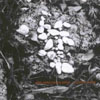 In many ways Sunder, Unite feels like a continuation of the dialogue that began with Block's first two recordings, Pure Gaze and Mobius Fuse,both released on Sedimental to much acclaim. For those records, herstyle of composition centered on ideas of combination and alignmentinstead of juxtaposition; the music achieved a subtle melding ofextremes: found sound with scored passages, orchestrated parts withimprovised elements, and live or "natural" space with the imaginedresonance of synthetic creation. The disparate pieces of Gaze and Fusecome together to create half-hour intervals of transcendence, subtlesound environments as quick to reject the atmospheric, mood-orientedinterpretation as they are to quietly envelop the most unwilling oflisteners. I feel carried through her deceptively thick and intricatecompositions, afloat on currents of de-sourced field recordings,invisibly suspended piano notes, wind and brass ensembles blowing in asif on short-wave frequency, and all manner of electronic blurts andorganic sounds, sometimes manipulated via sampler, though more oftenleft unruffled to hang like flies in the gleaming web of the whole. Thesensuous drift of these early recordings makes them challenging in thebest of ways; Block's thorough blending of the natural and artificialrealms introduces confusion and disorientation only in afterthought,almost through a willful suspension of disbelief. Even the harshest ofsounds used, such as the clashing rock and wood noise or fireworkexplosions in Mobius Fuse, Block treats with the care of asurgeon, guiding each into unique functionality without a scrap ofsensationalism or over-emphasis. Sunder, Unite works in similarways, but with an increasing stress on the motion and physicalmanifestation of the piece. This shift in momentum comes with thepresence of Seth Nehil, who played with Block in Austin's Alial Straaand whose impressive solo output focuses largely on rough, physicalsounds sourced in the natural world. Much of the sound on Sunder, Unitecomes from previous live and field recordings by Nehil and Block duringa Japanese tour where the duo's performances involved the live, oftenextreme manipulation of natural objects like leaves, grass, and rock.But while these shows seem easily located within the Japanese noisetradition or the influence of sound artists like Akio Suzuki, Sunder, Uniteis a truly foreign creation. The piece is rarely harsh, nor does it getcaught up in Suzuki's ponderous method. Block and Nehil recognize theessential physicality of their source material, but their arrangementsshow greater interest in leading the sounds through the composed dramaof the piece's movements ("through," "within," "beyond" etc). Theyaccomplish this through an elaborate cut-and-paste of the originalmaterial, including the insertion of large chunks of silence andglitch-ist sound-chopping. Elsewhere synthetic drones or heavilymanipulated pieces of the original tapes form swooning backdrops forthe microscopic clatter and pop painstakingly organized across the Sunder's40 minutes. Block's contributions become especially effective as a windensemble fades in and out wonderfully on a few tracks. As a whole, Sunder, Uniteechoes Block's previous work in particular, through the subtle way itbrings together (in this case aggressively) natural or organic soundand "artificial" elements of strict composition and digitaldeconstruction. The result is music less concerned with the detail orclash of different sounds than with synthesis and progression, analways-beautiful blending of disciplines.
In many ways Sunder, Unite feels like a continuation of the dialogue that began with Block's first two recordings, Pure Gaze and Mobius Fuse,both released on Sedimental to much acclaim. For those records, herstyle of composition centered on ideas of combination and alignmentinstead of juxtaposition; the music achieved a subtle melding ofextremes: found sound with scored passages, orchestrated parts withimprovised elements, and live or "natural" space with the imaginedresonance of synthetic creation. The disparate pieces of Gaze and Fusecome together to create half-hour intervals of transcendence, subtlesound environments as quick to reject the atmospheric, mood-orientedinterpretation as they are to quietly envelop the most unwilling oflisteners. I feel carried through her deceptively thick and intricatecompositions, afloat on currents of de-sourced field recordings,invisibly suspended piano notes, wind and brass ensembles blowing in asif on short-wave frequency, and all manner of electronic blurts andorganic sounds, sometimes manipulated via sampler, though more oftenleft unruffled to hang like flies in the gleaming web of the whole. Thesensuous drift of these early recordings makes them challenging in thebest of ways; Block's thorough blending of the natural and artificialrealms introduces confusion and disorientation only in afterthought,almost through a willful suspension of disbelief. Even the harshest ofsounds used, such as the clashing rock and wood noise or fireworkexplosions in Mobius Fuse, Block treats with the care of asurgeon, guiding each into unique functionality without a scrap ofsensationalism or over-emphasis. Sunder, Unite works in similarways, but with an increasing stress on the motion and physicalmanifestation of the piece. This shift in momentum comes with thepresence of Seth Nehil, who played with Block in Austin's Alial Straaand whose impressive solo output focuses largely on rough, physicalsounds sourced in the natural world. Much of the sound on Sunder, Unitecomes from previous live and field recordings by Nehil and Block duringa Japanese tour where the duo's performances involved the live, oftenextreme manipulation of natural objects like leaves, grass, and rock.But while these shows seem easily located within the Japanese noisetradition or the influence of sound artists like Akio Suzuki, Sunder, Uniteis a truly foreign creation. The piece is rarely harsh, nor does it getcaught up in Suzuki's ponderous method. Block and Nehil recognize theessential physicality of their source material, but their arrangementsshow greater interest in leading the sounds through the composed dramaof the piece's movements ("through," "within," "beyond" etc). Theyaccomplish this through an elaborate cut-and-paste of the originalmaterial, including the insertion of large chunks of silence andglitch-ist sound-chopping. Elsewhere synthetic drones or heavilymanipulated pieces of the original tapes form swooning backdrops forthe microscopic clatter and pop painstakingly organized across the Sunder's40 minutes. Block's contributions become especially effective as a windensemble fades in and out wonderfully on a few tracks. As a whole, Sunder, Uniteechoes Block's previous work in particular, through the subtle way itbrings together (in this case aggressively) natural or organic soundand "artificial" elements of strict composition and digitaldeconstruction. The result is music less concerned with the detail orclash of different sounds than with synthesis and progression, analways-beautiful blending of disciplines. samples:
 Kraakgeluiden is an ongoing and evolving series of events andperformances organized by a group of musicians based in Amsterdam. Likea smaller, Dutch version of the LA Free Music Society, Kraakgeluidenopens its door to musicians all over the world interested in improvisedelectroacoustic music, setting up weekly performances where musiciansfrom classical, jazz, improv, rock, even dance backgrounds, including aremarkable number of well-established personalities, perform beforeother members and guests of the loose collective. The musicians willoften play with others for the first time on the Kraakgeluiden stage,producing results that are sometimes mediocre, more often amazing, andalways interesting. Document 1is the first release from the collective and presumably not the last,compiling some of their best recorded moments to date. The disc comesin the wake of the recent inauguration of Werkplaats, a series of nineweekends in '03-'04 in which Kraakgeluiden pays for groups of musiciansto experiment for three days preparing for a Monday night performanceon the stage, held in a legalized squat in Amsterdam. The project aimsto eliminate the logistical problems (equipment-related, etc.) thatplague tighter scheduled events and to allow for deeper, more fullydeveloped communications between dissimilar musicians and their chosenmediums. Based on the music included here, it sounds as if they'resucceeding. The twelve pieces cover a huge amount of ground, rangingfrom sloppy, broad-stroked combative approaches, to nuanced moodpieces, and traversing the freest of jazz styling in between. Mosttracks utilize computers in some way, but the machines keep comfortabledistance, each musician clearly conscious of his or her presence withinthe group. While most everything bears the influence of electronicmusic making, these improvisations never slip into the faceless,formalist rut that is certainly a risk with this kind of undertaking.Even at their most indulgent, the tracks communicate the vivacity andprogressive nature of the collective, and oftentimes, the multitude ofstrange instruments, in stranger juxtapositions, is enough to keep thelistening experience interesting. This disc is worthwhile if only forthe inspiration it might lend to the formation of more organizationslike Kraakgeluiden.
Kraakgeluiden is an ongoing and evolving series of events andperformances organized by a group of musicians based in Amsterdam. Likea smaller, Dutch version of the LA Free Music Society, Kraakgeluidenopens its door to musicians all over the world interested in improvisedelectroacoustic music, setting up weekly performances where musiciansfrom classical, jazz, improv, rock, even dance backgrounds, including aremarkable number of well-established personalities, perform beforeother members and guests of the loose collective. The musicians willoften play with others for the first time on the Kraakgeluiden stage,producing results that are sometimes mediocre, more often amazing, andalways interesting. Document 1is the first release from the collective and presumably not the last,compiling some of their best recorded moments to date. The disc comesin the wake of the recent inauguration of Werkplaats, a series of nineweekends in '03-'04 in which Kraakgeluiden pays for groups of musiciansto experiment for three days preparing for a Monday night performanceon the stage, held in a legalized squat in Amsterdam. The project aimsto eliminate the logistical problems (equipment-related, etc.) thatplague tighter scheduled events and to allow for deeper, more fullydeveloped communications between dissimilar musicians and their chosenmediums. Based on the music included here, it sounds as if they'resucceeding. The twelve pieces cover a huge amount of ground, rangingfrom sloppy, broad-stroked combative approaches, to nuanced moodpieces, and traversing the freest of jazz styling in between. Mosttracks utilize computers in some way, but the machines keep comfortabledistance, each musician clearly conscious of his or her presence withinthe group. While most everything bears the influence of electronicmusic making, these improvisations never slip into the faceless,formalist rut that is certainly a risk with this kind of undertaking.Even at their most indulgent, the tracks communicate the vivacity andprogressive nature of the collective, and oftentimes, the multitude ofstrange instruments, in stranger juxtapositions, is enough to keep thelistening experience interesting. This disc is worthwhile if only forthe inspiration it might lend to the formation of more organizationslike Kraakgeluiden.samples:
- Colin McLean/Cor Fuhler/Andy Moor - kraak 09.12.2002
- Format Killer - kraak 21.04.2003
- Corkestra - kraak 05.12.2000
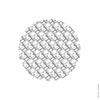 After some research I've learned that someone, or perhaps several nerds, working simultaneously in different countries (as these things usually occur), has developed software for turning Gameboys into sophisticated electronica machines. Ever one to outdo his peers, Matt Wand, former half of genre-defying, genre-destroying electronic duo Stock, Hausen, & Walkman and current Hot Air label head, has taken to eschewing the software altogether and doing live shows with nothing but the hand-held gaming devices and effects pedals in tow.
After some research I've learned that someone, or perhaps several nerds, working simultaneously in different countries (as these things usually occur), has developed software for turning Gameboys into sophisticated electronica machines. Ever one to outdo his peers, Matt Wand, former half of genre-defying, genre-destroying electronic duo Stock, Hausen, & Walkman and current Hot Air label head, has taken to eschewing the software altogether and doing live shows with nothing but the hand-held gaming devices and effects pedals in tow.



